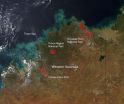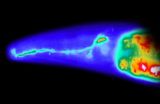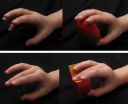Golgi trafficking controlled by G-proteins
2015-04-09
A family of proteins called G proteins are a recognized component of the communication system the human body uses to sense hormones and other chemicals in the bloodstream and to send messages to cells. In work that further illuminates how cells work, researchers at University of California, San Diego School of Medicine have discovered a new role for G proteins that may have relevance to halting solid tumor cancer metastasis.
The study is reported online April 9 in Developmental Cell.
"Our work provides the first direct evidence that G proteins are signaling on membranes ...
Fires in Western Australia April 2015
2015-04-09
Bushfires are inevitable in the fire-prone landscapes of Western Australia. Long dry summers, vegetation and undergrowth, and ignition from lightning or human causes mean that bushfires can and do occur every summer.
A bushfire is an unplanned fire (in the U.S. this is referred to as a wildfire). Each year Australia's Department of Parks and Wildlife responds to more than 600 bushfires that occur on or near land managed by the department. Bushfires have many causes, some natural such as lightning and some as a result of human activity such as camp fires, escapes from ...
Mental practice and physical therapy effective treatment for stroke, research shows
2015-04-09
ATLANTA--A combination of mental practice and physical therapy is an effective treatment for people recovering from a stroke, according to researchers at Georgia State University.
The findings, published on March 30 in the journal Frontiers in Human Neuroscience, examine how the brains of stroke patients change after treatment.
Mental practice and physical therapy are interventions used to improve impaired motor movement, coordination and balance following stroke. Mental practice, also known as motor imagery, is the mental rehearsal of a motor action without an overt ...
Scientists tackle our addiction to salt and fat by altering foods' pore size, number
2015-04-09
URBANA, Ill. - Two University of Illinois food scientists have learned that understanding and manipulating porosity during food manufacturing can affect a food's health benefits.
Youngsoo Lee reports that controlling the number and size of pores in processed foods allows manufacturers to use less salt while satisfying consumers' taste buds. Pawan Takhar has found that meticulously managing pore pressure in foods during frying reduces oil uptake, which results in lower-fat snacks without sacrificing our predilection for fried foods' texture and taste.
Both scientists ...
Choice of protein & carbohydrate-rich foods may have big effects on long-term weight gain
2015-04-09
BOSTON (April 9, 2015)- Making small, consistent changes to the types of protein- and carbohydrate-rich foods we eat may have a big impact on long-term weight gain, according to a new study led by researchers at the Friedman School of Nutrition Science & Policy at Tufts University. The results were published on-line this week in The American Journal of Clinical Nutrition.
Based on more than 16 years of follow-up among 120,000 men and women from three long-term studies of U.S. health professionals, the authors first found that diets with a high glycemic load (GL) from ...
'Warm blob' in Pacific Ocean linked to weird weather across the US
2015-04-09
The one common element in recent weather has been oddness. The West Coast has been warm and parched; the East Coast has been cold and snowed under. Fish are swimming into new waters, and hungry seals are washing up on California beaches.
A long-lived patch of warm water off the West Coast, about 1 to 4 degrees Celsius (2 to 7 degrees Fahrenheit) above normal, is part of what's wreaking much of this mayhem, according to two University of Washington papers to appear in Geophysical Research Letters, a journal of the American Geophysical Union.
"In the fall of 2013 and ...
Dealing with death in deployment
2015-04-09
April 9, 2015 - A new University of Utah study is the first to provide clear insight into contributors to suicide risk among military personnel and veterans who have deployed.
The study, published today in the journal Suicide and Life-Threatening Behavior, found that exposure to killing and death while deployed is connected to suicide risk. Previous studies that looked solely at the relationship between deployment and suicide risk without assessing for exposure to killing and death have shown inconsistent results.
"Many people assume that deployment equals exposure ...
Flip-flopping black holes spin to the end of the dance
2015-04-09
When black holes tango, one massive partner spins head over heels (or in this case heels over head) until the merger is complete, said researchers at Rochester Institute of Technology in a paper published in Physical Review Letters.
This spin dynamic may affect the growth of black holes surrounded by accretion disks and alter galactic and supermassive binary black holes, leading to observational effects, according to RIT scientists Carlos Lousto and James Healy.
The authors of the study will present their findings at the American Physical Society meeting in Baltimore ...
NASA sees Tropical Cyclone Joalane's winds consolidate around its eye
2015-04-09
The RapidScat instrument that flies aboard the International Space Station (ISS) provided data about Tropical Cyclone Joalane's surface winds that showed how the strongest sustained winds consolidated as the tropical cyclone intensified and developed an eye. As of April 9, warnings were in effect at Rodrigues Island in the Southern Indian Ocean as Joalane approached.
RapidScat measured the surface winds within Tropical Cyclone Joalane late on April 7 and on April 8, revealing that the strongest winds consolidated over a 24 hour period. RapidScat measured Joalane's winds ...
In the sea, a deadly form of leukemia is catching
2015-04-09
Outbreaks of leukemia that have devastated some populations of soft-shell clams along the east coast of North America for decades can be explained by the spread of cancerous tumor cells from one clam to another. Researchers call the discovery, reported in the Cell Press journal Cell on April 9, 2015, "beyond surprising."
"The evidence indicates that the tumor cells themselves are contagious--that the cells can spread from one animal to another in the ocean," said Stephen Goff of the Howard Hughes Medical Institute and Columbia University. "We know this must be true because ...
Brain activity in infants predicts language outcomes in autism spectrum disorder
2015-04-09
Autism spectrum disorder (ASD) can produce strikingly different clinical outcomes in young children, with some having strong conversation abilities and others not talking at all. A study published by Cell Press April 9th in Neuron reveals the reason: At the very first signs of possible autism in infants and toddlers, neural activity in language-sensitive brain regions is already similar to normal in those ASD toddlers who eventually go on to develop good language ability but nearly absent in those who later have a poor language outcome.
"Why some toddlers with ASD get ...
Stem cell disease model clarifies bone cancer trigger
2015-04-09
Using induced pluripotent stem cells (iPSCs), a team led by Mount Sinai researchers has gained new insight into genetic changes that may turn a well known anti-cancer signaling gene into a driver of risk for bone cancers, where the survival rate has not improved in 40 years despite treatment advances.
The study results, published today in the journal Cell, revolve around iPSCs, which since their 2006 discovery have enabled researchers to coax mature (fully differentiated) bodily cells (e.g. skin cells) to become like embryonic stem cells. Such cells are pluripotent, able ...
How the brain balances risk-taking and learning
2015-04-09
LA JOLLA--If you had 10 chances to roll a die, would you rather be guaranteed to receive $5 for every roll ($50 total) or take the risk of winning $100 if you only roll a six?
Most animals, from roundworms to humans, prefer the more predictable situation when it comes to securing resources for survival, such as food. Now, Salk scientists have discovered the basis for how animals balance learning and risk-taking behavior to get to a more predictable environment. The research reveals new details on the function of two chemical signals critical to human behavior: dopamine--responsible ...
Mutation causes mice to behave as if they have an eating disorder
2015-04-09
A genetic mutation associated with an increased risk of developing eating disorders in humans has now been found to cause several behavioral abnormalities in mice that are similar to those seen in people with anorexia nervosa. The findings, published online April 9 in Cell Reports, may point to novel treatments to reverse behavioral problems associated with disordered eating.
"It's been known for a long time that about 50% to 70% of the risk of getting an eating disorder was inherited, but the identity of the genes that mediate this risk is unknown," explains senior author ...
Touch-sensing neurons are multitaskers
2015-04-09
Two types of touch information -- the feel of an object and the position of an animal's limb -- have long been thought to flow into the brain via different channels and be integrated in sophisticated processing regions. Now, with help from a specially devised mechanical exoskeleton that positioned monkeys' hands in different postures, Johns Hopkins researchers have challenged that view. In a paper published in the April 22 issue of Neuron, they present evidence that the two types of information are integrated as soon as they reach the brain by sense-processing brain cells ...
Ocean myth busted: 'Toddler' sea turtles are very active swimmers
2015-04-09
It turns out sea turtles, even at a tender 6-18 months of age, are very active swimmers. They don't just passively drift in ocean currents as researchers once thought. NOAA and University of Central Florida researchers say it's an important new clue in the sea turtle "lost years" mystery. Where exactly turtles travel in their first years of life, before returning to coastal areas as adults to forage and reproduce, has puzzled scientists for decades.
"All species of sea turtles are endangered or threatened under the Endangered Species Act; knowing their distribution is ...
Gene loss creates eating disorder-related behaviors in mice
2015-04-09
Building on their discovery of a gene linked to eating disorders in humans, a team of researchers at the University of Iowa has now shown that loss of the gene in mice leads to several behavioral abnormalities that resemble behaviors seen in people with anorexia nervosa.
The team, led by Michael Lutter, MD, PhD, assistant professor of psychiatry in the UI Carver College of Medicine, found that mice that lack the estrogen-related receptor alpha (ESRRA) gene are less motivated to seek out high-fat food when they are hungry and have abnormal social interactions. The effect ...
Can facial plastic surgery make you more likeable?
2015-04-09
WASHINGTON -- Facial plastic surgery may do more than make you look youthful. It could change -- for the better -- how people perceive you. The first study of its kind to examine perception after plastic surgery finds that women who have certain procedures are perceived as having greater social skills and are more likeable, attractive and feminine.
The study is not superficial -- the importance of facial appearance is rooted in evolution and studies suggest that judging a person based on his or her appearance boils down to survival. The results were published online ...
Facial plastic surgery improves perception of femininity, personality, attractiveness
2015-04-09
Facial rejuvenation surgery may not only make you look younger, it may improve perceptions of you with regard to likeability, social skills, attractiveness and femininity, according to a report published online by JAMA Facial Plastic Surgery.
The relationship between facial features and personality traits has been studied in other science fields, but it is lacking in the surgical literature, according to the study background.
Michael J. Reilly, M.D., of the MedStar Georgetown University Hospital, Washington, and coauthors measured the changes in personality perception ...
Axillary lymph node evaluation performed frequently in ductal carcinoma in situ
2015-04-09
Axillary lymph node evaluation is performed frequently in women with ductal carcinoma in situ breast cancer, despite recommendations generally against such an assessment procedure in women with localized cancer undergoing breast-conserving surgery, according to a study published online by JAMA Oncology.
While axillary lymph node evaluation is the standard of care in the surgical management of invasive breast cancer, a benefit has not been demonstrated in ductal carcinoma in situ (DCIS). For women with invasive breast cancer, sentinel lymph node biopsy (SLNB) replaced ...
Breakthrough finds molecules that block previously 'undruggable' protein tied to cancer
2015-04-09
LAWRENCE -- A team of scientists at the University of Kansas has pinpointed six chemical compounds that thwart HuR, an "oncoprotein" that binds to RNA and promotes tumor growth.
The findings, which could lead to a new class of cancer drugs, appear in the current issue of ACS Chemical Biology.
"These are the first reported small-molecule HuR inhibitors that competitively disrupt HuR-RNA binding and release the RNA, thus blocking HuR function as a tumor-promoting protein," said Liang Xu, associate professor of molecular biosciences and corresponding author of the paper.
The ...
Signal variability and cognitive performance in the aging human brain
2015-04-09
As we age, the physical make up of our brains changes. This includes changes in neural processing in grey matter, but also in the deterioration of structural connections in the brain, which allow communication between distinct brain regions, so the brain is able to work as a well-wired network system.
Researchers at the Lifelong Brain and Cognition Lab at the Beckman Institute for Advanced Science and Technology at the University of Illinois have utilized the magnetic resonance imaging (MRI) facilities available in Beckman's Biomedical Imaging Center to measure the moment-to-moment ...
Maternal and Child Health Handbook promotes antenatal care visits
2015-04-09
Every year, 300,000 pregnant women and 2,600,000 newborn babies are estimated to die worldwide, and more than 99% of these deaths occur in developing countries. Effective interventions to reduce maternal and neonatal mortality are critically needed, and an ongoing challenge for researchers and health professionals is finding the best way to deliver these interventions in resource-limited settings such as Mongolia. Antenatal visits can provide the first opportunity to deliver these interventions. Now, a new study has shown that Japan's flagship intervention, the Maternal ...
Delicate magnolia scent activates human pheromone receptor
2015-04-09
The question if humans can communicate via pheromones in the same way as animals is under debate. Cell physiologists at the Ruhr-Universität Bochum have demonstrated that the odorous substance Hedione activates the putative pheromone receptor VN1R1, which occurs in the human olfactory epithelium. Together with colleagues from Dresden, the Bochum-based researchers showed that the scent of Hedione generates sex-specific activation patters in the brain, which do not occur with traditional fragrances. "These results constitute compelling evidence that a pheromone effect ...
Drug regulations tied to fewer prescriptions of effective gout drug
2015-04-09
Well intentioned, but costly and potentially problematic. That's how researchers describe the end result of a decision by the Food and Drug Administration (FDA) to regulate colchicine, a drug used to treat gout, among other ailments. Fewer patients are actually now taking it, and it has come at a cost to their wallets, says study leader Aaron Kesselheim of Brigham and Women's Hospital and the Harvard Medical School in the US. The findings¹ appear in the Journal of General Internal Medicine,² published by Springer.
Colchicine had been sold at low cost for many ...
[1] ... [2925]
[2926]
[2927]
[2928]
[2929]
[2930]
[2931]
[2932]
2933
[2934]
[2935]
[2936]
[2937]
[2938]
[2939]
[2940]
[2941]
... [8709]
Press-News.org - Free Press Release Distribution service.







